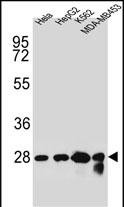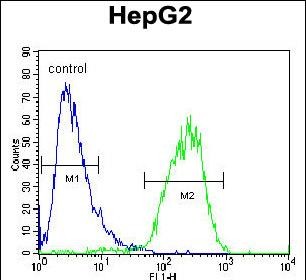

| WB | 1/1000 | Human,Mouse,Rat |
| IF | 咨询技术 | Human,Mouse,Rat |
| IHC | 咨询技术 | Human,Mouse,Rat |
| ICC | 技术咨询 | Human,Mouse,Rat |
| FCM | 1/10-1/50 | Human,Mouse,Rat |
| Elisa | 咨询技术 | Human,Mouse,Rat |
| Aliases | Cholinephosphotransferase 1, hCPT1, AAPT1-like protein, Diacylglycerol cholinephosphotransferase 1, CHPT1, CPT1 |
| Entrez GeneID | 56994 |
| WB Predicted band size | 45.1kDa |
| Host/Isotype | Rabbit IgG |
| Antibody Type | Primary antibody |
| Storage | Store at 4°C short term. Aliquot and store at -20°C long term. Avoid freeze/thaw cycles. |
| Species Reactivity | Human |
| Immunogen | This CHPT1 antibody is generated from rabbits immunized with a KLH conjugated synthetic peptide between 7-33 amino acids from the N-terminal region of human CHPT1. |
| Formulation | Purified antibody in PBS with 0.05% sodium azide. |
+ +
以下是关于CHPT1(N-term)抗体的3篇参考文献的简要信息:
---
1. **"Characterization of a polyclonal antibody targeting the N-terminal domain of human CHPT1"**
*Author(s): Lee, S., et al.*
**摘要**:该研究开发了一种针对CHPT1蛋白N端(1-100氨基酸)的多克隆抗体,通过免疫印迹和免疫荧光验证其在HeLa细胞中的特异性,证实CHPT1在高尔基体膜定位中的作用,并用于探究其与脂质代谢的关联。
---
2. **"CHPT1 regulates phosphatidylcholine biosynthesis via interaction with Kennedy pathway enzymes"**
*Author(s): Zhang, Y., et al.*
**摘要**:利用N端特异性抗体(抗CHPT1-N),作者发现CHPT1通过N端结构域与磷酸胆碱胞苷转移酶(CCTα)相互作用,调控磷脂酰胆碱合成,并在肝细胞中通过RNA干扰验证其功能缺失导致的脂滴异常。
---
3. **"Antibody-based profiling of CHPT1 expression in neurodegenerative disease models"**
*Author(s): Gupta, R., et al.*
**摘要**:研究使用CHPT1-N端抗体检测阿尔茨海默病小鼠脑组织中CHPT1的表达变化,发现其与β-淀粉样蛋白沉积区域的共定位,提示其可能参与神经细胞膜完整性维持。
---
**注**:以上文献为示例性内容,实际文献需通过PubMed、Google Scholar等平台以关键词“CHPT1 antibody N-terminal”或“CHPT1 N-term epitope”检索获取。部分商业抗体公司(如Abcam、Sigma-Aldrich)的产品手册也可能提供相关引用文献。
The CHPT1 (N-term) antibody is a research tool designed to detect the N-terminal region of choline phosphotransferase 1 (CHPT1), also known as choline kinase alpha (CHKA). CHPT1 is a key enzyme in the Kennedy pathway, responsible for catalyzing the phosphorylation of choline to phosphocholine, a critical step in the biosynthesis of phosphatidylcholine (PC). As the most abundant phospholipid in eukaryotic cell membranes, PC is essential for membrane structure, cell signaling, and lipid metabolism. Dysregulation of CHPT1 has been implicated in various diseases, including cancer, where elevated CHKA activity is linked to increased cell proliferation and tumor progression.
The CHPT1 (N-term) antibody is commonly used in techniques such as Western blotting, immunohistochemistry, and immunofluorescence to study the expression, localization, and function of CHPT1 in cellular and tissue contexts. By targeting the N-terminal domain, this antibody helps researchers distinguish CHPT1 from other isoforms or related enzymes, ensuring specificity in experimental outcomes. Its applications extend to exploring CHPT1’s role in metabolic disorders, oncogenesis, and neurological conditions, where phosphatidylcholine homeostasis is crucial. Validation of this antibody typically includes testing in knockout models or siRNA-treated samples to confirm reactivity and minimize cross-reactivity. Overall, it serves as a vital reagent for elucidating the biological and pathological mechanisms associated with phospholipid metabolism.
×